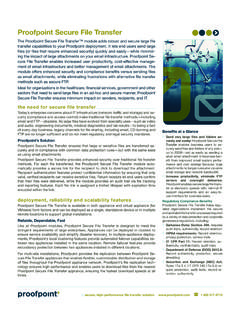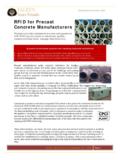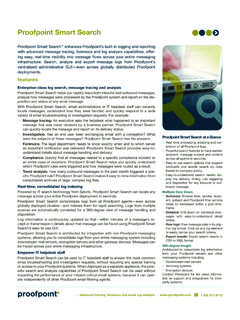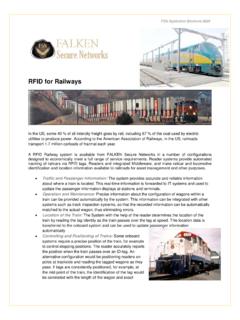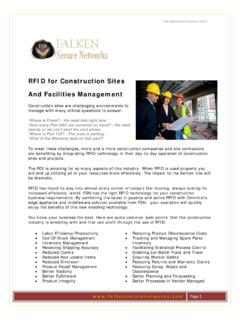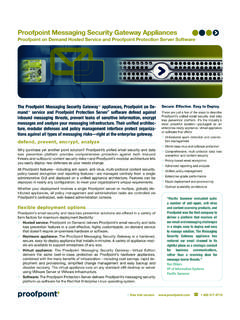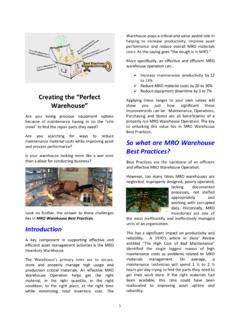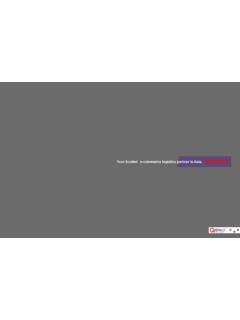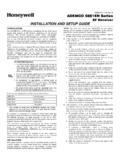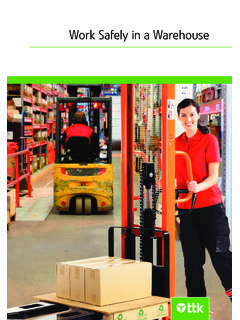Transcription of FSN Brochure 0823 RFID for the Steel Industry
1 FSN Application Brochure 0823. rfid for the Steel Industry The major products of Steel mills are typically Steel slabs, rebar, pipe and coils. rfid technology has now successfully overcome the physics challenges of metal environments. rfid can be especially valuable in industries like Steel which can be characterized as capacity-constrained with a high cost of lost production. At the Mill Today, handling activities are performed by visually identifying a product, writing down its identifier and entering the information into the appropriate IT-system, involving time, manual effort, and the risk of human error. Some companies have implemented barcode technology, but this approach provides partial automation only with people still required for tedious manual scanning. Using rfid at key points along the supply chain can streamline and automate many handling activities.
2 Thyssen-Krupp is an acknowledged rfid leader in the Steel Industry . ThyssenKrupp Steel will use rfid at its new Steel mill in the Bay of Sepetiba, Brazil, which is scheduled to start production of 5 million metric tons of Steel per year in 2009. It will also use rfid at harbours in Rotterdam, Netherlands, and Duisburg, Germany, to identify every Steel slab automatically and to speed up the unloading process. The company needed an automated system to identify more than 100,000 Steel slabs per year because of the tight unloading times when clearing sea vessels from their cargo. There is a window of less than three minutes per slab when clearing cargo that must be maintained at all times. Any delay would likely create additional cost. Another interesting recent application uses rfid to track hot rolled Steel coils.
3 Instead of tracking it with chalk in the cooling yard once it cools down to 800 degrees Fahrenheit, a $15 active tag with a ceramic base is used. The company benefits from increased efficiency which lowers its costs. From the Mill to Ship and Train Later, a passive tag is used for tracking during transportation through the supply chain. Because of high fees for landing and docking ships at European harbors and a limited number of cranes to unload the ships, the company must limit the time it takes workers to unload to a maximum of three minutes per slab. By quickly identifying the slabs, rfid helped speed the process of determining which slabs go on which Page 1 FSN Application Brochure 0823. barges and railcars. Part of the Steel was taken to ThyssenKrupp Steel 's hot rolling mill in Bochum, and other slabs go up the Rhine to the plant in Duisburg-Walsum.
4 The last interrogation happened with fixed rfid readers along the production line before the slab was sent into the reheating furnace to be rolled into a coil. The partners may also identify further interrogation points at other destination sites. Tags have been thoroughly tested to make sure they would be readable after going through harsh conditions during transit, such as being washed with seawater and exposed to temperature changes, snow, ice, bumps and knocks. Bar-code labels were ruled out as a method of tracking the slabs since ice, dirt or salt buildup could hinder the ability to scan the bar code to identify the slab, and time was short for moving the slabs around. The fast moving process means that manual tracking of the slabs simply isn't possible. Further reasons why bar codes were ruled out: strong sunlight could lighten the black-white contrast necessary for bar codes to be read, and make it unreliable to identify moving objects.
5 There are no auto- focusing bar-code readers that can reliably read over distances of several meters under these conditions. Currently, ThyssenKrupp Steel is integrating the rfid application with its IT systems. Industry -standard EPC Gen 2 tags are attached with adhesive to the middle of the side of each slab at a seaport. They contain EPC Class 1 Gen 2 UHF rfid inlays, which operate at 860 to 950 MHz, so that they will work in all countries where ThyssenKrupp Steel does business. Tags are encoded with a 10-digit unique ID (part of the EPC number) linked in ThyssenKrupp Steel 's IT system to information on the slab's Steel grade, dimensions, customer and destination. At present, such information is tracked manually, and slabs are marked with a 10-digit number sprayed with heat-resistant aluminum ink.
6 The partners chose EPC inlays because of their global availability and competitive pricing. They also wanted to keep the option of possibly using EPCglobal's software-based EPCIS standard for systems used to store and share tag-related data. Today slabs are only used internally for production of coils and other end products, but in the future they may also be traded with other Steel companies or even end customers. Therefore, the exchange of information via EPCIS might be a future scenario. Once the application is up and running, slabs will be identified about seven times during their journey from Brazil to the German processing plants. ThyssenKrupp Steel tested several rfid readers mounted on a crane used to hoist the slabs off of the ship and onto barges and railcars. The readers, made by Alien Technology, interrogated slabs while they were suspended about 3 meters aboveground.
7 The system then tells the crane operator where to place the slab. Once the system is fully implemented, fixed crane readers will be used at each point and handhelds will be used as backups in case a tag is damaged and a new one needs to be applied and encoded. Flag Tags for slab logistics The advantage of rfid , and specifically of UHF rfid , is its capability to read data from a greater distance than barcode without the need for line-of- sight. However, while UHF delivers long read ranges and high data throughput rates, its readability and performance become limited when in close proximity of metal which distort, or deflect the radio wave signals as well as potentially short out the radio wave energy needed to energize the tag so it can communicate . A Flag Tag is a field-proven tag technology embedded with the short dipole Gen 2 inlay, forming a rfid tag in the shape of a flag during the Page 2 FSN Application Brochure 0823.
8 Encoding, printing and application process thus lifting the rfid inlay (in the flag ) away from the surface of the product. For this particular application, the Flag Tag was customized to meet the requirements of tagging and adhering onto Steel slabs. With a Flag Tag and its extended read-range, the rfid reader can now uniquely and accurately identify the slabs while they are suspended at times up to three meters from the gantry cranes. rfid for the Steel Bar, Sheet, and Coil Service Centres Transporting slabs, bars, sheets and coils between different slitting production lines, company sites or to third parties for finishing and back, represents a significant portion of activity in the supply chain and transportation tends to present the greatest number of potential challenges along the way.
9 Analysis conducted by Accenture and ThyssenKrupp Steel has shown that, in general, the business case for rfid . in slab and coil logistics makes most sense when there is a significant amount of transportation required between production sites or a significant amount of coil locating to be done. Inter-site transport requires secure identification and as has been shown in this document, the effort required for workers to identify slabs and coils increases costs and reduces efficiency while introducing the risk of human error and safety issues. Production and finishing steps can only move forward when half-products are available and are delivered accurately and on time. Optimal vehicle management is crucial. Many Steel companies own larger than necessary fleets of trucks, trailers, railcars and heavy lifting vehicles.
10 Even if third parties own transportation vehicles, rfid technology can contribute to better resource management. Since reading bar code labels one by one is a labor intensive job , rfid is a good solution for identification of each coil when both overhead cranes and forklifts move and store coils. The Steel Service Centre application is similar to other production, warehouse and logistics operations. Both the overhead crane and the forklift operator should have a rfid Reader, and when he comes close to the coil, he can identify it. In addition, the system will keep track of where coils are which have been moved to gain access to the target coil. When the crane moves a coil into storage, the coil ID number and the storage location are both captured and coordinated in a database so plant workers know where each coil is located.
